Intel Core Duo: AOpen i975Xa-YDG to the Rescue
by Gary Key on May 4, 2006 8:00 AM EST- Posted in
- Motherboards
Synthetic Graphics Performance
The 3DMark series of benchmarks developed and provided by Futuremark are among the most widely used tools for benchmark reporting and comparisons. Although the benchmarks are very useful for providing apple to apple comparisons across a broad array of GPU and CPU configurations they are not a substitute for actual application and gaming benchmarks. In this sense we consider the 3DMark benchmarks to be purely synthetic in nature but still valuable for providing consistent measurements of performance.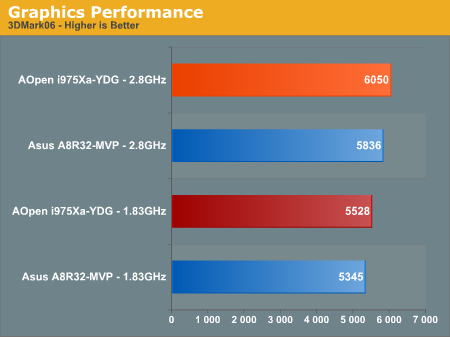
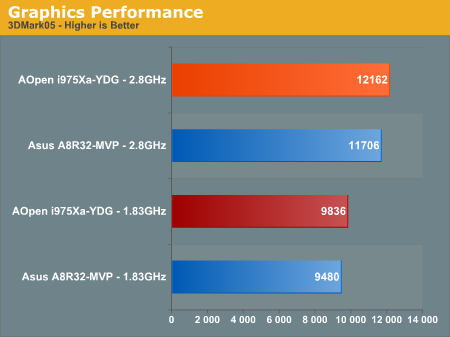
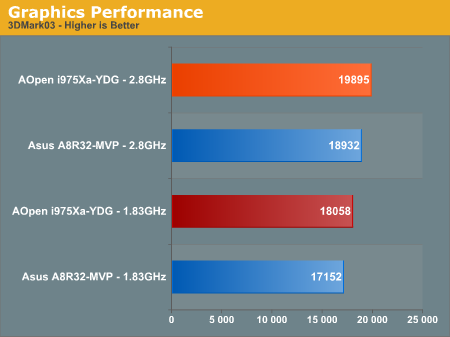
In our first tests, the combination of the Intel Core Duo and AOpen i975Xa-YDG makes for an impressive showing against the AMD Opteron 165/175 and Asus A8R32-MVP setup at both stock and overclocked settings. The Intel platform had no issues running the full 3DMark series when overclocked but our AMD platform struggled at first until we dialed in the right mix of voltages and memory settings.
General System Performance
The PCMark05 benchmark developed and provided by Futuremark was designed for determining overall system performance for the typical home computing user. This tool provides both system and component level benchmarking results utilizing subsets of real world applications or programs. This benchmark is useful for providing comparative results across a broad array of Graphics subsystems, CPU, Hard Disk, and Memory configurations along with multithreading results. In this sense we consider the PCMark benchmark to be both synthetic and real world in nature while providing consistency in our benchmark results.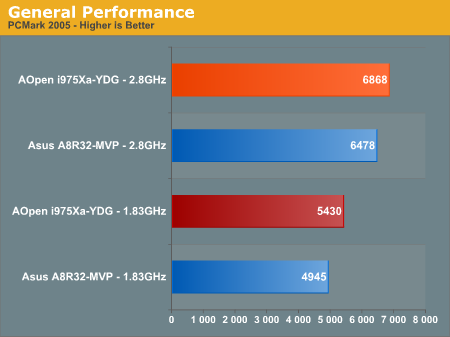
The margins are closer in the PCMark05 results but the Intel platform continues to show an advantage over the AMD platform at stock and overclocked settings. It is obvious from our test results that we can expect even greater results from the Conroe and Merom processor series.
Rendering Performance
We have added the Cinebench 9.5 and POV-RAY 3.6 benchmarks as they heavily stress the CPU subsystem while performing graphics modeling and rendering. We utilize the standard benchmark demos in each program along with the default settings. Cinebench 9.5 features two different benchmarks with one test utilizing a single core and the second test showcasing the power of multiple cores in rendering the benchmark image. We had planned on generating 3dsmax 7 benchmarks but our AMD platform would not complete the underwater benchmark. We are still investigating this issue.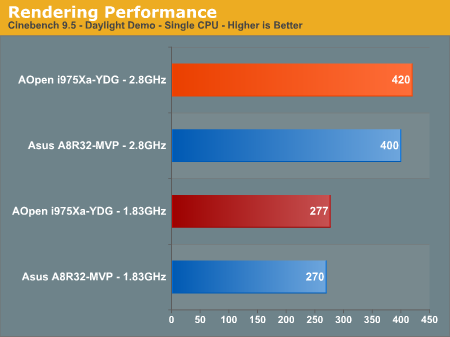
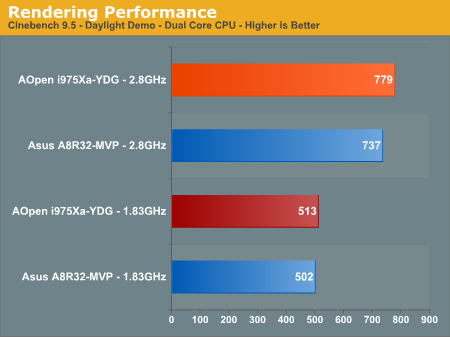
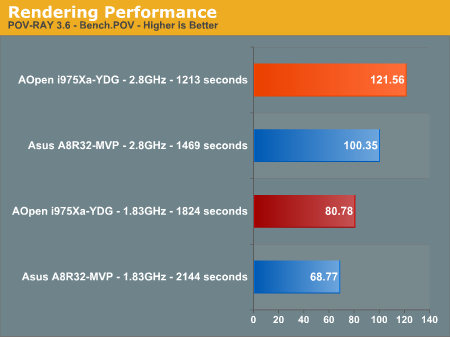
The Intel Core Duo desktop platform showed its strength in the extremely demanding POV-RAY benchmark, bettering the AMD platform by 18%. In our limited testing with the Asus N4L-VM featuring the 945GM mobile chipset our stock Intel Core Duo numbers were slightly better than the AMD platform in the Cinebench 9.5 benchmark and only about 6% greater in the POV-RAY benchmark indicating AOpen's choice of the i975x chipset certainly makes a difference in the performance ability of the Core Duo.










81 Comments
View All Comments
Viditor - Thursday, May 4, 2006 - link
Premiere Pro 2.0 has a 64 bit version that works very well. It has not yet been "optimized" for 64 bit (meaning that basic functions won't run much faster), but you have access to 4 GB+ of memory (which can be a HUGE help when dealing with very large movie and audio files).http://www.adobe.com/products/premiere/pdfs/premie...">Adobe Premiere Pro 2.0 pdf
Griswold - Thursday, May 4, 2006 - link
This was obviously a test of a mobile CPU on a desktop platform, so his point is valid. And what does SFF have to do with it?Calin - Thursday, May 4, 2006 - link
That more than 50% overclock is mind boggling - I hope this will bode well for the soon-to-be released Intel processors. Performance as good as or better than Opteron 175? Looks like Intel already have this side of the market covered.xsilver - Thursday, May 4, 2006 - link
have intel chipset limitations been discussed on the upcoming conroe?wont all conroes be runnning 1066fsb already? meaning there is little headroom left for fsb overclocking unless some serious progress is made on the new chipsets?
(300ish fsb is the current general limit for intel chipsets right?)
Gary Key - Thursday, May 4, 2006 - link
We felt guilty when raising the voltage up to 1.3875 as temps increased from 25c to 31c, makes you wonder what a really good heatsink/fan will on this board. :) Anyway, I think we reached the limit of our board around 267fsb in further testing with a water cooling unit. I am sure the CPU had more in it as temps were around 26c at load, or maybe not. We spoke with AOpen and it appears the boards will top out around 275FSB at this time, we had an early board and based upon some user experiences the retail boards are doing around 275 at this time. We have a retail board on the way for our HTPC article.
Griswold - Thursday, May 4, 2006 - link
What was the ambient (room) temperature?Gary Key - Thursday, May 4, 2006 - link
It varies during the day, variation is 20c~22c. There is a new program out that will measure the Yonah core temperature through the on-chip diode instead of the AOpen thermal sensor. I withheld our temperature and power consumption numbers until we decide which temperature reading to report as another utility in XP gives a slightly different reading also. Power consumption is excellent.
Our test system (11x255, ~2.8GHz)-
X1900XT
idle - 114w
load - 232w
X1900 CrossFire (P4 of video cards)
idle - 139w
load - 357w
redbone75 - Thursday, May 4, 2006 - link
That price is a bit daunting for a mobo. This is where if you absolutely have to build a PC right now I would go with an AMD system b/c you still get stellar performance at a lower price point. The A8R32-MVP is a little under $200, and the Opty 165 still costs less than the Core Duo T2400. So, although this is a great effort from Aopen, I personally would build the AMD system or just wait for Conroe/Merom to launch. Boy, but does this make your mouth water if you choose the latter, doesn't it?dexvx - Sunday, May 7, 2006 - link
Lol, what happened to the fanboi arguement of saving power for the long term (if you visit the AT forms, its frequently used arguement for not buying a cheap Pentium-D system)? Based on the powerdraw tests from Tech-report.com, you save more power going from a X2 to Yonah than from Pentium-D to X2.That Aside, this Aopen board *is* Meron compatible with a bios update. The folks over at xtremesystems.org has confirmed it.
Schmeh - Thursday, May 4, 2006 - link
I absolutely agree. I have been putting of upgrading my system for almost a year and I am glad that I did. I can't wait to see what Conroe and Merom have to offer. My only fear is that Intel will overprice them at launch.